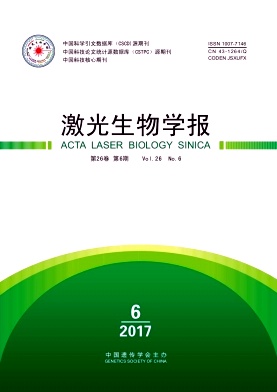GIP受体激动剂类药物筛选模型的构建
[1] FEHER M D, BRAZIER J, SCHAPER N, et al. Patients’ with type 2 diabetes willingness to pay for insulin therapy and clinical outcomes[J]. Bmj Open Diabetes Res Care, 2016, 4(1): e000192.
[2] SCOTTB W, SU J K, GARY K Y, et al. A GIP receptor agonist exhibits β-Cell anti-apoptotic actions in rat models of diabetes resulting in improved β-Cell function and glycemic control[J]. Plos One, 2010, 5(3): e9590.
[3] BAHTIYAR G, GUTTERMAN D, LEBOVITZ H. Heart failure: a major cardiovascular complication of diabetes mellitus[J]. Current Diabetes Reports, 2016,16(11): 116.
[4] FRIDLYAND L E, P HILIPSON L H. Pancreatic beta cell G-protein coupled receptors and second messenger interactions: asystems biology computational analysis[J]. Plos One, 2016, 11(5): e0152869.
[5] BO A. Islet G protein-coupled receptors as potential targets for treatment of type 2 diabetes[J]. Nature Reviews Drug Discovery, 2009, 8(5): 369-385.
[6] 盛灵通, 孔建龙, 秦健, 等. GLP-1及其类似物治疗糖尿病的研究进展[J]. 糖尿病新世界, 2015, 22(2): 22-23.
SHENG Tongling, KONG Jianlong, QIN Jian, et al. Research progress of GLP-1 and its analogues in the treatment of diabetes mellitus[J]. New World of Diabetes, 2015, 22(2): 22-23.
[7] NIGEL I, PETER R F. New perspectives on exploitation of incretin peptides for the treatment of diabetes and related disorders[J]. World Journal of Diabetes, 2015, 6(15): 1285.
[8] WANG T, MA X, TANG T, et al. The effect of glucose-dependent insulinotropic polypeptide (GIP) variants on visceral fat accumulation in Han Chinese populations[J]. Nutrition & Diabetes, 2017, 7(5): e278.
[9] CARR R D, LARSEN M O, WINZELL M S, et al. Incretin and islet hormonal responses to fat and protein ingestion in healthy men[J]. American Journal of Physiology Endocrinology & Metabolism, 2008, 295(4): E779.
[10] MEIER J J, GALLWITZ B, SIEPMANN N, et al. Gastric inhibitory polypeptide (GIP) dose-dependently stimulates glucagon secretion in healthy human subjects at euglycaemia[J]. Diabetologia, 2003, 46(6): 798-801.
[11] MOHAMMAD S, PATEL R T, BRUNO J, et al. A naturally occurring GIP receptor variant undergoes enhanced agonist-induced desensitization, which impairs GIP control of adipose insulin sensitivity[J]. Molecular & Cellular Biology, 2014, 34(19): 3618-3629.
[12] PENG W, FIASCHITAESCH N M, VASAVADA R C, et al. Diabetes mellitus[mdash]advances and challenges in human [beta]-cell proliferation[J]. Nature Reviews Endocrinology, 2015, 11(4): 201.
[13] KAHN S E, COOPERM E, DELP S. Pathophysiology and treatment of type 2 diabetes: perspectives on the past, present, and future[J]. Lancet, 2014, 383(9922): 1068.
[14] CALANNA S, CHRISTENSEN M, HOLST J J, et al. Secretion of glucose-dependent insulinotropic polypeptide in patients with type 2 diabetes: systematic review and meta-analysis of clinical studies[J]. Diabetes Care, 2013, 36(10): 3346.
[15] 谢洁琼, 吕秋军, 温利青, 等. 基于报告基因和PPARγ信号通路的药物筛选模型的建立[J]. 中国药理学通报, 2005, 21(4): 504-507.
XIE Jieqiong, LU Qiujun, WEN Liqing, et al. Development of drug screening modelbased on reporter gene and the signal transduction of PPARγ[J]. Chinese Pharmacological Bulletin,2005,21(4): 504-507.
[16] 黎思彤, 郑雪萍, 杨学敏, 等. 以 GLP-1受体为靶点的药物筛选模型的建立及功能鉴定[J]. 中国药理学通报, 2017, 33(2): 285-289.
LI Sitong, ZHENG Xueping, YANG Xuemin, et al. Development and evaluation of a cell model targeted on GLP-1 receptor[J]. Chinese Pharmacological Bulletin, 2017, 33(2): 285-289.
[17] 曾璐漫. GLP1受体激动剂类药物筛选模型的构建[D]. 湖南农业大学, 2015.
ZENG Luman. Construct the drug screening model for GLP-1 receptor agonists[D]. Hunan Agricultural University, 2015.
[18] 谢洁琼. 抗糖尿病药物筛选模型的建立及应用[D]. 中国人民解放军军事医学科学院, 解放军军事医学科学院, 2005.
XIE Jieqiong. The development and application of the methods of scerening for the anti-diabetie drugs[D]. Academy of Military Medical Sciences, 2015.
[19] MARTIN C M, IWIN N, FLATTP R, et al. A novel acylated form of (d-Ala(2))GIP with improved antidiabetic potential, lacking effect on body fat stores[J]. Biochimica et Biophysica Acta, 2013, 1830(6): 3407.
[20] ZHANG X, KIM K M. Multifactorial regulation of G protein-coupled receptor endocytosis[J]. Biomolecules & Therapeutics, 2017, 25(1): 26.
[21] TEITLER M, KLEIN M T. A new approach for studying GPCR dimers: drug-induced inactivation and reactivation to reveal GPCR dimer function in vitro, in primary culture, and in vivo[J]. Pharmacol Ther, 2012, 133(2): 205-217.
[22] 李胜, 白波, 陈京. G蛋白偶联受体脱敏內吞和复敏调控机制进展[J]. 济宁医学院学报, 2016, 39(2): 123-127.
LI Sheng, BAI Bo, CHEN Jing. Regulatoty mechanisms of G protein coupled receptor about desensitization,endocytosis and resensitization[J]. Journal of Jining Medical College, 2016, 39(2): 123-127.
[23] COHEN L J, ESTERHAZY D, KIM S H, et al. Commensal bacteria make GPCR ligands that mimic human signalling molecules[J]. Nature, 2017, 549: 48-53.
周海燕, 吴艳阳, 刘东波, 谢红旗. GIP受体激动剂类药物筛选模型的构建[J]. 激光生物学报, 2017, 26(6): 534. ZHOU Haiyan, WU Yanyang, LIU Dongbo, XIE Hongqi. Construction of Screening Model for GIP Receptor Agonists[J]. Acta Laser Biology Sinica, 2017, 26(6): 534.



